
SEA STAR WASTING DISEASE
This narrative describes observations made on sea star populations in southern British Columbia where I dive. But major SSWD events have occurred all along the Pacific coast and more information about them can be accessed via the links provided.
Prior to the autumn of 2013 we had observed extraordinarily high densities of the SUNFLOWER STAR Pycnopodia helianthoides on rocky slopes in Howe Sound, a coastal British Columbia fjord located just NW of Vancouver. At some sites these stars occupied a wide band in the shallow subtidal zone with densities of up 12 per square metre. Scientists were unable to explain how or why such high densities had developed.
Toward the end of August, 2013, divers began seeing SUNFLOWER STARS dying in alarming numbers. They reported hundreds that appeared to be disintegrating, their rays falling off and their bodies turning into "puddles of goo." Dubbed SEA STAR WASTING DISEASE (SSWD), this phenomenon quickly spread through the entire SUNFLOWER STAR population, killing an estimated tens of thousands in Howe Sound alone. By the end of October, virtually all the SUNFLOWER STARS were dead.
While SUNFLOWER STARS bore the brunt of the disease, other stars were also dying, including the MORNING SUN STAR Solaster dawsoni, GIANT PINK STAR Pisaster brevispinus, MOTTLED STAR Evasterias troschelii, PURPLE STAR Pisaster ochraceus, VERMILION STAR Mediaster aequalis, RAINBOW STAR Orthasterias koehleri, and STRIPED SUN STAR Solaster stimpsoni. These stars were more widely distributed and less numerous throughout Howe Sound, yet they were dying in a similar way as the SUNFLOWER STARS. Eventually more than 20 different species were found to be affected by SSWD.
Howe Sound appeared to be “ground zero” for SSWD, as there had been few reports of mortality from other areas of the PNW. But surveys in nearby Indian Arm, another coastal fjord where there had also been abnormally high densities of SUNFLOWER STARS, revealed a similar sudden mass die-off in October 2013.
On October 9, 2013 the population of SUNFLOWER STARS at Croker Island (near the head of Indian Arm) was still very large, although some dying animals were observed. But by October 29 the population had suffered nearly 100% mortality. All of the SUNFLOWER STARS had been reduced to extensive mats of white bacteria. The MORNING SUN STARS were also decimated and many MOTTLED STARS were dying.
By late October the disease had been reported from the Gulf Islands, around Nanaimo and into Puget Sound and the San Juan Islands. It gradually spread throughout the entire Strait of Georgia and Puget Sound and north to the central BC coast.
There have been sea star die-offs documented in the past in Barkley Sound. In 2009 Bates et al reported on wasting disease present in the population of PURPLE STARS (Pisaster ochraceus). They observed that the wasting disease in Pisaster was highly temperature sensitive and that populations in sheltered bays appeared to sustain chronic, low levels of infection.
In 2014 scientists examined the diseased tissue of affected stars from Howe Sound and Indian Arm and found that a virus was responsible for the rapid decline and death of the stars. For a discussion of the disease and an account of their findings, view
Since the outbreak of SSWD in 2013 the recovery of sea stars in the PNW has been uneven. Some populations of MOTTLED STARS and PURPLE STARS seem to have bounced back, but in BC waters SUNFLOWER STARS and MORNING SUN STARS have made virtually no sustained recovery. The removal of these top-level predators has dramatically changed the ecology of rocky reefs. At many sites, sea urchin populations have exploded and their grazing activities have stripped reefs completely bare of seaweeds. The lack of shelter and bottom cover previously provided by the kelp seems to have forced spawning lingcod and greenlings to find other places to lay their eggs.
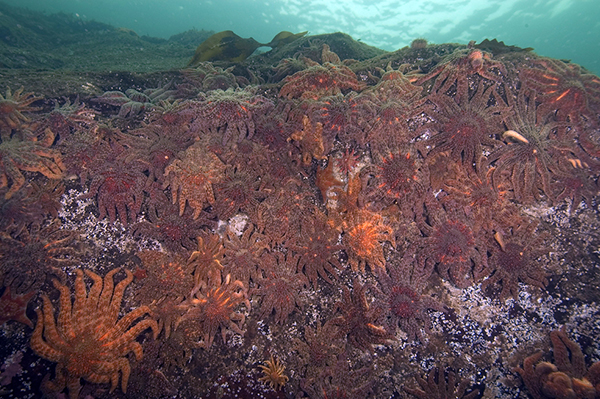
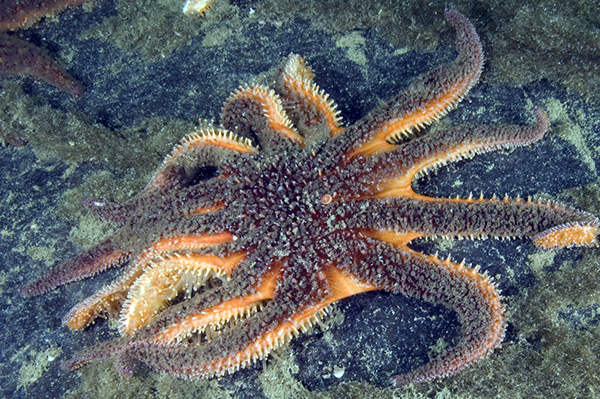
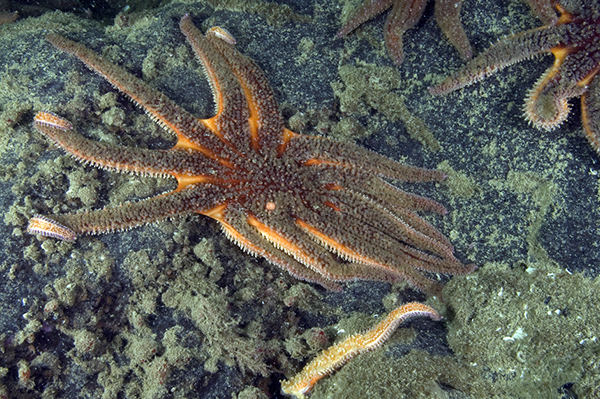
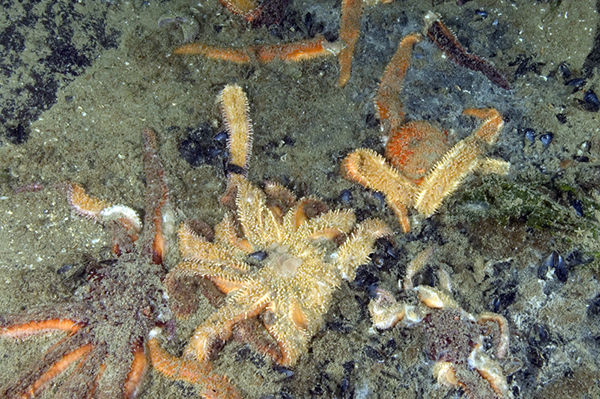
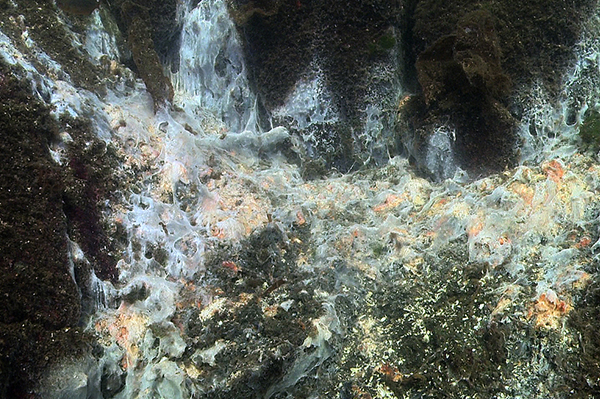
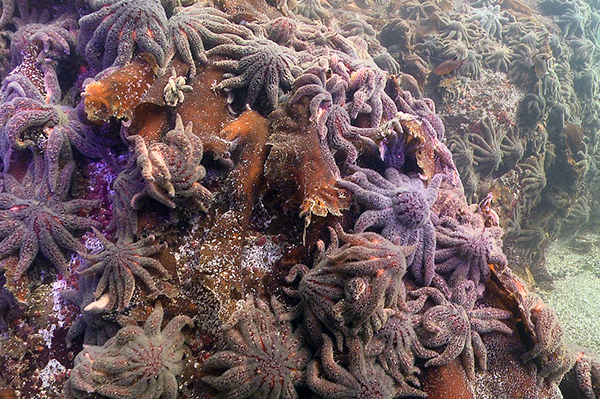
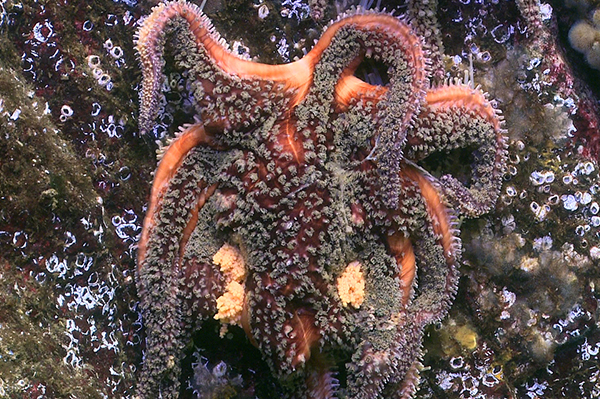
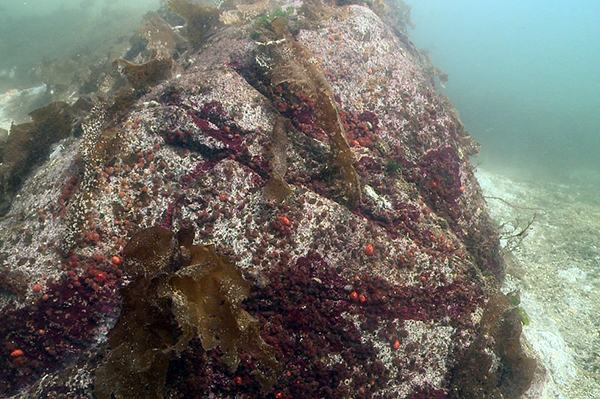
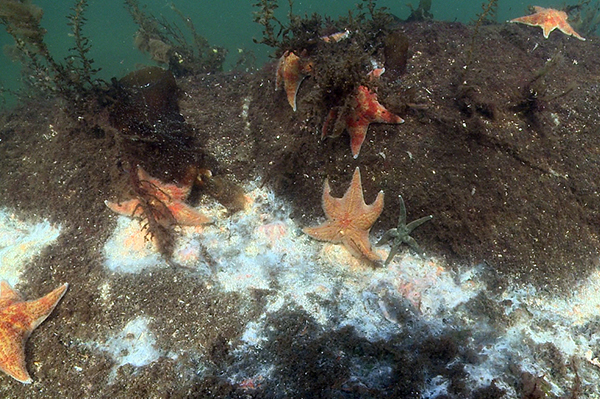
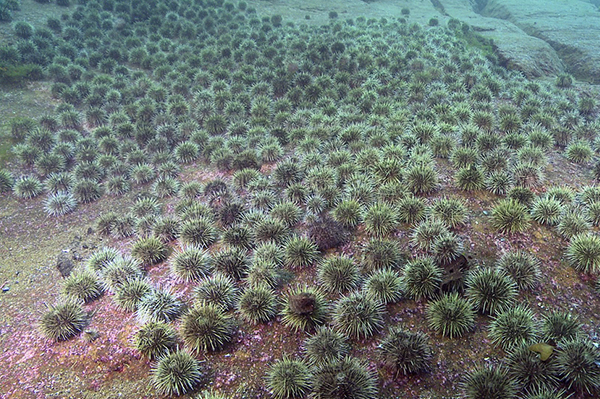
A rocky slope at the Defence Islands in Howe Sound, BC, is densely packed with apparently healthy SUNFLOWER STARS in December 2010. Healthy animals are usually plump with puffy arms. There were up to a dozen per square metre in the shallow subtidal zone. Super densities like this were common through Howe Sound.
In September 2013 the SUNFLOWER STARS at the Defence Islands started to die. This star exhibits the first signs of SSWD. In the initial stages the animals become much flatter and the edges of the arms become more distinct. They still move about but appear emaciated.
Within days the SUNFLOWER STARS started to drop their arms (which often wandered off on their own for a short while) and developed lesions.
Eventually, the SUNFLOWER STARS could no longer grip the steep slope and tumbled to the bottom, ending up in rotting piles.
Bacteria soon consumed the remains of the SUNFLOWER STARS, leaving ghostly white mats on the bottom.
A rocky outcrop in the shallow subtidal zone at Croker Island, Indian Arm, BC on October 9, 2013. There were hundreds of SUNFLOWER STARS in the area and while most appeared healthy some showed early signs of disease.
This SUNFLOWER STAR at Croker Island is barely alive, its body riddled with lesions and parts of its internal organs spilling out.
On October 29, 2013, just 20 days later, all of the SUNFLOWER STARS at Croker Island were dead. The same rocky outcrop photographed only three weeks earlier looked dramatically different. Note the mound of bacteria at the base of the rock.
One of the few stars that seemed more resistant to SSWD was the LEATHER STAR (Dermasterias imbricata). Here several crawl over the rotting remains of dozens of SUNFLOWER STARS on October 29, 2013 at Croker Island, Indian Arm.
The summit of a small reef in Sechelt Inlet, BC, in January 2018. Green sea urchin populations have exploded in the absence of top predators such as SUNFLOWER STARS, and they have eaten virtually all of the kelp that once covered this rock.
9 - 10
Previous
NEXT
ADDITIONAL INFORMATION ABOUT SSWD
Bates AE, Hilton BJ, Harley, CDG 2009. Effects of temperature, season and locality on wasting disease in the keystone predatory sea star Pisaster ochraceus. Diseases of Aquatic Organisms Vol. 86:245-251.
Vancouver Aquarium
www.aquablog.ca/2013/11/family-relations-in-starfish-wasting-syndrome/
University of California at Santa Cruz
The Marine Detective by Jackie Hildering
Echinoblog by Dr. Chris Mah
NBC News Item
INTRODUCTION | ABOUT SEA STARS | BIOLOGY | SPECIES | PREDATORS / PREY | SEA STAR WASTING DISEASE | ACKNOWLEDGEMENTS | FIELD GUIDE | VIDEO
Copyright © 2018 All rights reserved.
